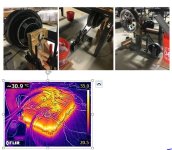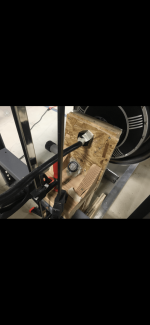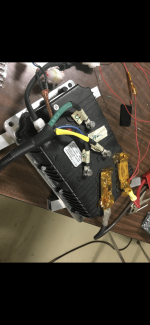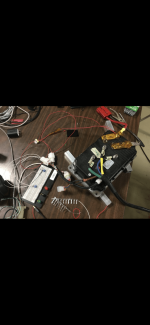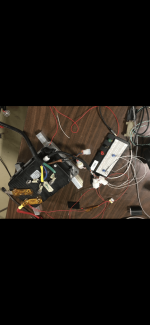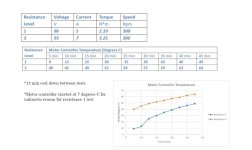How is the controller placed within the system?
Currently out of the system due to testing, in an open space.
I notice in the included FLIR image it shows you have the heatsink facing down, against an unknown material surface (wooden table? hard to tell in the FLIR image), but where the FLIR shows it is not able to do it's job of removing the heat from the controller by radiation and convection (without a cooling setup or heatsink, that's the best it could hope for).
I would guess, from that, and some of the other info provided, but without complete information on everything, that the most likely thing is that the controller is simply unable to get rid of the waste heat it is generating, with radiation away from and convection airflow over it's built-in heatsink plate being blocked by the surface it's sitting on.
My first recommendation is simply to flip the controller over on it's "back" so the built-in heatsink plate is facing up where it can radiate and convect away some of the heat. (just make sure you're not touching the wire connections to anything electrically conductive in the process)
My next would be to bolt it to a thermally-conductive surface to help carry the heat away.
Beyond that, there's some other questions below before I could determine anything else.
SolarCarLoverBoy said:
Is the motor also getting hot?
NO
In the test setup you have pictured, it's possible that's because there is airflow over it from it spinning, and there is a significant heatsink in the form of the wheel hub and motor casing. What temperature does the hub, and the casing, get to, over the same period that the controller temperature increases? And what is it's starting temperature?
Is there an internal temperature sensor for the motor that you can monitor (perhaps via the controller's software)? The internal temperature can be different than the outside, though usually this evens out over a long period of the same load.
What throttle level are you running the system at when it gets hot?
Motor speed – 200 rpm.
Throttle level: 64
Is 64 half of the full throttle? Or some other percentage of the throttle? Also, is this throttle controlling the speed of the motor, or the phase current?
If it is half of full throttle, that could be enough for the controller to produce significant heat, even just on a test stand, depending on settings, design, and wiring.
How much "resistance" does the load you're using provide against the motor turning?
The image above had a resistance of ~2 N*m. When ran with no load the motor controller still reached 55 C in 45 min.
Does the controller get warmer than ambient when just running the motor without any load on it, at either minimum or full throttle?
Yes, started at 20 rose to 55 degrees C in 45 minutes
Was that at minimum or full throttle, or some other setting?
What is the complete setup?
Since this question wasnt' answered in text, did you intend to answer it with the images? If so, it appears to show some of the test equipment and background, but it does not explain the electrical connections and whatnot. Could you please describe the complete setup, such as how you are controlling throttle input, the system wiring, and anything else that you can? I'm sure you know exactly what everything in the images is, but it's not self-evident what all of it is to us.

What kind of cooling do you have setup for it? It probably requires significant airflow, heatsinking, etc. for other than no-load conditions
.
No current heat sink, and since it is in an open space for testing we have no fans on it.
I don't know what the manual says, but I expect it requires more cooling than it is getting, for the test conditions. However, another test you can do is to just power it on and let it sit, under exactly the same conditions it is now, and see what it's temperature rise is. If it still rises signficantly above ambient, when not doing anything but sitting powered on, it probably means it has an inefficient LVPS in it and requires heatsinking for sure...but I'd still check the manual (or with Kelly support). If it does not rise, then it means the load on it is enough to cause this heating, and that could mean either that it just needs heatsinking under load (manual; kelly support) or that there is a problem with the timing of the motor phase pulses relative to the hall signals, which usually means it is the wrong phase / hall combination.
What kind of wiring setup do you have between it and the motor, and it and the battery?
Since this was not answered in text, did you intend it to be answered by the images? If so, it doesn't have enough information. Could you state specifically which wires are connected, to which other wires, and which kind of wires are used?
How much battery current and/or phase current is being drawn/provided by the controller under no-load conditions? How much under the "resistance load" conditions?
no load:
Under load: 1
1 what? (watt, amp, milliamp, kiloamp, etc?, and is that the battery current or the phase current?)
And what was the current draw under no-load? Your answer doesn't have a number (or units, etc).



